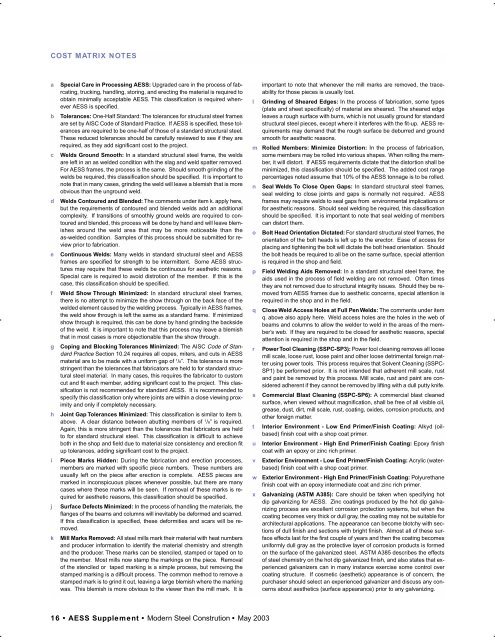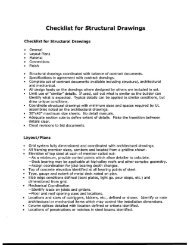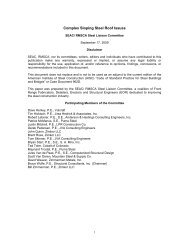Architecturally Exposed Structural Steel - Arquitectura en acero
Architecturally Exposed Structural Steel - Arquitectura en acero
Architecturally Exposed Structural Steel - Arquitectura en acero
You also want an ePaper? Increase the reach of your titles
YUMPU automatically turns print PDFs into web optimized ePapers that Google loves.
COST MATRIX NOTES<br />
a Special Care in Processing AESS: Upgraded care in the process of fabrcating,<br />
trucking, handling, storing, and erecting the material is required to<br />
obtain minimally acceptable AESS. This classification is required wh<strong>en</strong>ever<br />
AESS is specified.<br />
b Tolerances: One-Half Standard: The tolerances for structural steel frames<br />
are set by AISC Code of Standard Practice. If AESS is specified, these tolerances<br />
are required to be one-half of those of a standard structural steel.<br />
These reduced tolerances should be carefully reviewed to see if they are<br />
required, as they add significant cost to the project.<br />
c Welds Ground Smooth: In a standard structural steel frame, the welds<br />
are left in an as welded condition with the slag and weld spatter removed.<br />
For AESS frames, the process is the same. Should smooth grinding of the<br />
welds be required, this classification should be specified. It is important to<br />
note that in many cases, grinding the weld will leave a blemish that is more<br />
obvious than the unground weld.<br />
d Welds Contoured and Bl<strong>en</strong>ded: The comm<strong>en</strong>ts under item k. apply here,<br />
but the requirem<strong>en</strong>ts of contoured and bl<strong>en</strong>ded welds add an additional<br />
complexity. If transitions of smoothly ground welds are required to contoured<br />
and bl<strong>en</strong>ded, this process will be done by hand and will leave blemishes<br />
around the weld area that may be more noticeable than the<br />
as-welded condition. Samples of this process should be submitted for review<br />
prior to fabrication.<br />
e Continuous Welds: Many welds in standard structural steel and AESS<br />
frames are specified for str<strong>en</strong>gth to be intermitt<strong>en</strong>t. Some AESS structures<br />
may require that these welds be continuous for aesthetic reasons.<br />
Special care is required to avoid distrotion of the member. If this is the<br />
case, this classification should be specified.<br />
f Weld Show Through Minimized: In standard structural steel frames,<br />
there is no attempt to minimize the show through on the back face of the<br />
welded elem<strong>en</strong>t caused by the welding process. Typically in AESS frames,<br />
the weld show through is left the same as a standard frame. If minimized<br />
show through is required, this can be done by hand grinding the backside<br />
of the weld. It is important to note that this process may leave a blemish<br />
that in most cases is more objectionable than the show through.<br />
g Coping and Blocking Tolerances Minimized: The AISC Code of Standard<br />
Practice Section 10.24 requires all copes, miters, and cuts in AESS<br />
material are to be made with a uniform gap of 1 /8”. This tolerance is more<br />
string<strong>en</strong>t than the tolerances that fabricators are held to for standard structural<br />
steel material. In many cases, this requires the fabricator to custom<br />
cut and fit each member, adding significant cost to the project. This classification<br />
is not recomm<strong>en</strong>ded for standard AESS. It is recomm<strong>en</strong>ded to<br />
specify this classification only where joints are within a close viewing proximity<br />
and only if completely necessary.<br />
h Joint Gap Tolerances Minimized: This classification is similar to item b.<br />
above. A clear distance betwe<strong>en</strong> abutting members of 1 /8” is required.<br />
Again, this is more string<strong>en</strong>t than the tolerances that fabricators are held<br />
to for standard structural steel. This classification is difficult to achieve<br />
both in the shop and field due to material size consist<strong>en</strong>cy and erection fit<br />
up tolerances, adding significant cost to the project.<br />
i Piece Marks Hidd<strong>en</strong>: During the fabrication and erection processes,<br />
members are marked with specific piece numbers. These numbers are<br />
usually left on the piece after erection is complete. AESS pieces are<br />
marked in inconspicuous places wh<strong>en</strong>ever possible, but there are many<br />
cases where these marks will be se<strong>en</strong>. If removal of these marks is required<br />
for aesthetic reasons, this classification should be specified.<br />
j Surface Defects Minimized: In the process of handling the materials, the<br />
flanges of the beams and columns will inevitably be deformed and scarred.<br />
If this classification is specified, these deformities and scars will be removed.<br />
k Mill Marks Removed: All steel mills mark their material with heat numbers<br />
and producer information to id<strong>en</strong>tify the material chemistry and str<strong>en</strong>gth<br />
and the producer. These marks can be st<strong>en</strong>ciled, stamped or taped on to<br />
the member. Most mills now stamp the markings on the piece. Removal<br />
of the st<strong>en</strong>ciled or taped marking is a simple process, but removing the<br />
stamped marking is a difficult process. The common method to remove a<br />
stamped mark is to grind it out, leaving a large blemish where the marking<br />
was. This blemish is more obvious to the viewer than the mill mark. It is<br />
16 AESS Supplem<strong>en</strong>t Modern <strong>Steel</strong> Constrution May 2003<br />
important to note that wh<strong>en</strong>ever the mill marks are removed, the traceability<br />
for those pieces is usually lost.<br />
l Grinding of Sheared Edges: In the process of fabrication, some types<br />
(plate and sheet specifically) of material are sheared. The sheared edge<br />
leaves a rough surface with burrs, which is not usually ground for standard<br />
structural steel pieces, except where it interferes with the fit-up. AESS requirem<strong>en</strong>ts<br />
may demand that the rough surface be deburred and ground<br />
smooth for aesthetic reasons.<br />
m Rolled Members: Minimize Distortion: In the process of fabrication,<br />
some members may be rolled into various shapes. Wh<strong>en</strong> rolling the member,<br />
it will distort. If AESS requirem<strong>en</strong>ts dictate that the distortion shall be<br />
minimized, this classification should be specified. The added cost range<br />
perc<strong>en</strong>tages noted assume that 10% of the AESS tonnage is to be rolled.<br />
n Seal Welds To Close Op<strong>en</strong> Gaps: In standard structural steel frames,<br />
seal welding to close joints and gaps is normally not required. AESS<br />
frames may require welds to seal gaps from <strong>en</strong>vironm<strong>en</strong>tal implications or<br />
for aesthetic reasons. Should seal welding be required, this classification<br />
should be specified. It is important to note that seal welding of members<br />
can distort them.<br />
o Bolt Head Ori<strong>en</strong>tation Dictated: For standard structural steel frames, the<br />
ori<strong>en</strong>tation of the bolt heads is left up to the erector. Ease of access for<br />
placing and tight<strong>en</strong>ing the bolt will dictate the bolt head ori<strong>en</strong>tation. Should<br />
the bolt heads be required to all be on the same surface, special att<strong>en</strong>tion<br />
is required in the shop and field.<br />
p Field Welding Aids Removed: In a standard structural steel frame, the<br />
aids used in the process of field welding are not removed. Oft<strong>en</strong> times<br />
they are not removed due to structural integrity issues. Should they be removed<br />
from AESS frames due to aesthetic concerns, special att<strong>en</strong>tion is<br />
required in the shop and in the field.<br />
q Close Weld Access Holes at Full P<strong>en</strong> Welds: The comm<strong>en</strong>ts under item<br />
q. above also apply here. Weld access holes are the holes in the web of<br />
beams and columns to allow the welder to weld in the areas of the member’s<br />
web. If they are required to be closed for aesthetic reasons, special<br />
att<strong>en</strong>tion is required in the shop and in the field.<br />
r Power Tool Cleaning (SSPC-SP3): Power tool cleaning removes all loose<br />
mill scale, loose rust, loose paint and other loose detrim<strong>en</strong>tal foreign matter<br />
using power tools. This process requires that Solv<strong>en</strong>t Cleaning (SSPC-<br />
SP1) be performed prior. It is not int<strong>en</strong>ded that adher<strong>en</strong>t mill scale, rust<br />
and paint be removed by this process. Mill scale, rust and paint are considered<br />
adher<strong>en</strong>t if they cannot be removed by lifting with a dull putty knife.<br />
s Commercial Blast Cleaning (SSPC-SP6): A commercial blast cleaned<br />
surface, wh<strong>en</strong> viewed without magnification, shall be free of all visible oil,<br />
grease, dust, dirt, mill scale, rust, coating, oxides, corrosion products, and<br />
other foreign matter.<br />
t Interior Environm<strong>en</strong>t - Low End Primer/Finish Coating: Alkyd (oilbased)<br />
finish coat with a shop coat primer.<br />
u Interior Environm<strong>en</strong>t - High End Primer/Finish Coating: Epoxy finish<br />
coat with an epoxy or zinc rich primer.<br />
v Exterior Environm<strong>en</strong>t - Low End Primer/Finish Coating: Acrylic (waterbased)<br />
finish coat with a shop coat primer.<br />
w Exterior Environm<strong>en</strong>t - High End Primer/Finish Coating: Polyurethane<br />
finish coat with an epoxy intermediate coat and zinc rich primer.<br />
x Galvanizing (ASTM A385): Care should be tak<strong>en</strong> wh<strong>en</strong> specifying hot<br />
dip galvanizing for AESS. Zinc coatings produced by the hot dip galvanizing<br />
process are excell<strong>en</strong>t corrosion protection systems, but wh<strong>en</strong> the<br />
coating becomes very thick or dull gray, the coating may not be suitable for<br />
architectural applications. The appearance can become blotchy with sections<br />
of dull finish and sections with bright finish. Almost all of these surface<br />
effects last for the first couple of years and th<strong>en</strong> the coating becomes<br />
uniformly dull gray as the protective layer of corrosion products is formed<br />
on the surface of the galvanized steel. ASTM A385 describes the effects<br />
of steel chemistry on the hot dip galvanized finish, and also states that experi<strong>en</strong>ced<br />
galvanizers can in many instance exercise some control over<br />
coating structure. If cosmetic (aesthetic) appearance is of concern, the<br />
purchaser should select an experi<strong>en</strong>ced galvanizer and discuss any concerns<br />
about aesthetics (surface appearance) prior to any galvanizing.







